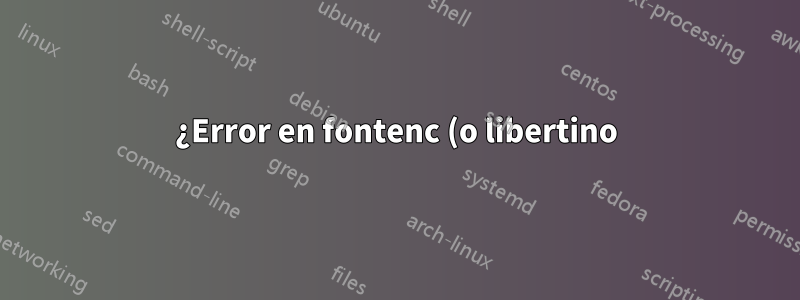%3F.png)
Estoy trabajando en un libro con aprox. Más de 200 páginas A5. En el proceso de migración de pdflatex a xelatex noté algunas diferencias importantes en el diseño. En un esfuerzo por localizar el problema, seguí MWE para pdflatex.
\documentclass[paper=a5,pagesize,fontsize=13pt]{scrbook}
\usepackage{showframe}
\usepackage[T1]{fontenc}
\usepackage[osf]{libertine}
\begin{document}
Hello, here is some text without a meaning. This text
should show what a printed text will look like at this place.
\end{document}
Si
\usepackage[T1]{fontenc}
está vigente, la primera línea de texto termina con "Este texto". Si se comenta, termina con "Este texto debería" y también produce un cuadro demasiado lleno.
Respuesta1
La diferencia se debe a
OT1:
.\OT1/LinuxLibertineT-TOsF/m/n/13 i
.\OT1/LinuxLibertineT-TOsF/m/n/13 n
.\OT1/LinuxLibertineT-TOsF/m/n/13 g
.\OT1/LinuxLibertineT-TOsF/m/n/13 .
.\glue 3.7921 plus 4.875 minus 0.36096
.\OT1/LinuxLibertineT-TOsF/m/n/13 (ligature Th)
.\OT1/LinuxLibertineT-TOsF/m/n/13 i
.\OT1/LinuxLibertineT-TOsF/m/n/13 s
.\glue 3.25 plus 1.625 minus 1.08289
.\OT1/LinuxLibertineT-TOsF/m/n/13 t
.\OT1/LinuxLibertineT-TOsF/m/n/13 e
.\kern-0.091
.\OT1/LinuxLibertineT-TOsF/m/n/13 x
.\OT1/LinuxLibertineT-TOsF/m/n/13 t
T1:
....\T1/LinuxLibertineT-TOsF/m/n/13 i
....\T1/LinuxLibertineT-TOsF/m/n/13 n
....\T1/LinuxLibertineT-TOsF/m/n/13 g
....\T1/LinuxLibertineT-TOsF/m/n/13 .
....\glue 3.7921 plus 4.875 minus 0.36096
....\T1/LinuxLibertineT-TOsF/m/n/13 T
....\T1/LinuxLibertineT-TOsF/m/n/13 h
....\T1/LinuxLibertineT-TOsF/m/n/13 i
....\T1/LinuxLibertineT-TOsF/m/n/13 s
....\glue 3.25 plus 1.625 minus 1.08289
....\T1/LinuxLibertineT-TOsF/m/n/13 t
....\T1/LinuxLibertineT-TOsF/m/n/13 e
....\kern-0.091
....\T1/LinuxLibertineT-TOsF/m/n/13 x
....\T1/LinuxLibertineT-TOsF/m/n/13 t
es decir, la fuente OT1 tiene una ligadura Th que no está presente en la fuente T1. Esto es algo sorprendente pero no necesariamente un error. Después de eso, las longitudes de las palabras son ligeramente diferentes, lo que es suficiente para hacer que el salto de línea del párrafo tome una ruta diferente.
Podrías evitar la ligadura como
\documentclass[paper=a5,pagesize,fontsize=13pt]{scrbook}
\usepackage{showframe}
%\usepackage[T1]{fontenc}
\usepackage[osf]{libertine}
%\showoutput
\begin{document}
Hello, here is some text without a meaning. T{}his text
should show what a printed text will look like at this place.
\end{document}
Respuesta2
Puede desactivar la temida ligadura Th en las fuentes OT1 cargando microtypey emitiendo
\DisableLigatures[T]{encoding=OT1}
pero esto tiene el inconveniente de que también el interletraje contra T está desactivado, como muestra el siguiente ejemplo.
\documentclass[paper=a5,pagesize,fontsize=13pt]{scrbook}
\usepackage{showframe}
\usepackage[T1]{fontenc}
\usepackage[osf]{libertine}
\usepackage{microtype}
\DisableLigatures[T]{encoding=OT1}
\begin{document}
\fontencoding{OT1}\selectfont
Hello, here is some text without a meaning. This text
should show what a printed text will look like at this place.
To
\fontencoding{T1}\selectfont
Hello, here is some text without a meaning. This text
should show what a printed text will look like at this place.
To
\end{document}

Entonces no hay una solución real a su problema. Puede pedirle al responsable del libertinepaquete que agregue una opción para deshabilitar la ligadura Th en la codificación OT1 (se necesita un nuevo conjunto de fuentes virtuales). En mi opinión, esto sería unmuyBuena característica, ya que la ligadura me parece realmente horrible.


